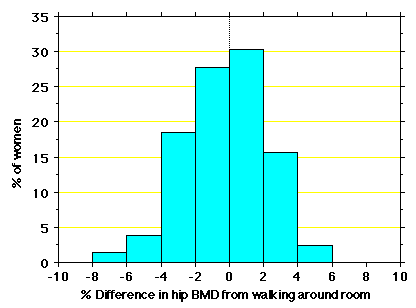Reproducibility
Studies frequently report reproducibility of DEXA between 1 and 2%. This is the average precision; the range is rarely reported. But repeat measurements may show as much as 7% difference. These charts shows the percent difference in total hip bone density when 300 normal elderly men and women walked around the room between measurements.

Cummulative Frequency Plot for repeat hip DEXA
|
| Hip DEXA change from walking around room
| | % BMD CHANGE | % of women | Report |
| 0 - 2 | 50.8 | Within machine precision
|
|---|
| 2 - 4 | 34.2 | Mild, non-significant change
|
|---|
| 4 - 6 | 6.3 | Probable change, but not statistically significant
|
|---|
| >6 | 1.5 | Significant change
|
|---|
|

Histogram of the results in the women
Variations from year to year in the machine readings, technologists, and positioning will further decrease the reproducibility. These errors cause the phenomenon of "regression to the mean"; women who apparently lose a great amount of bone during the first year of a clinical trial will then apparently gain it back over the second year (Cummings). If other clinical clues suggest that a loss is real (the patient had a fracture, weight loss, serious illness with bedrest, started steroids) then one might act on a change of 3 or 4%, but too often a patient is doing very well and a loss of 3% in one year is met with alarm and unnecessary medication.
Patient positioning is the major source of error in repeat bone density tests. Clinicians should examine the bone density printouts, especially with hip measurements, to see if there are noticeable differences in the position or the area measured.
See if you can find the
mistakes in these examples!
| 
|
Updated 1/6/06






